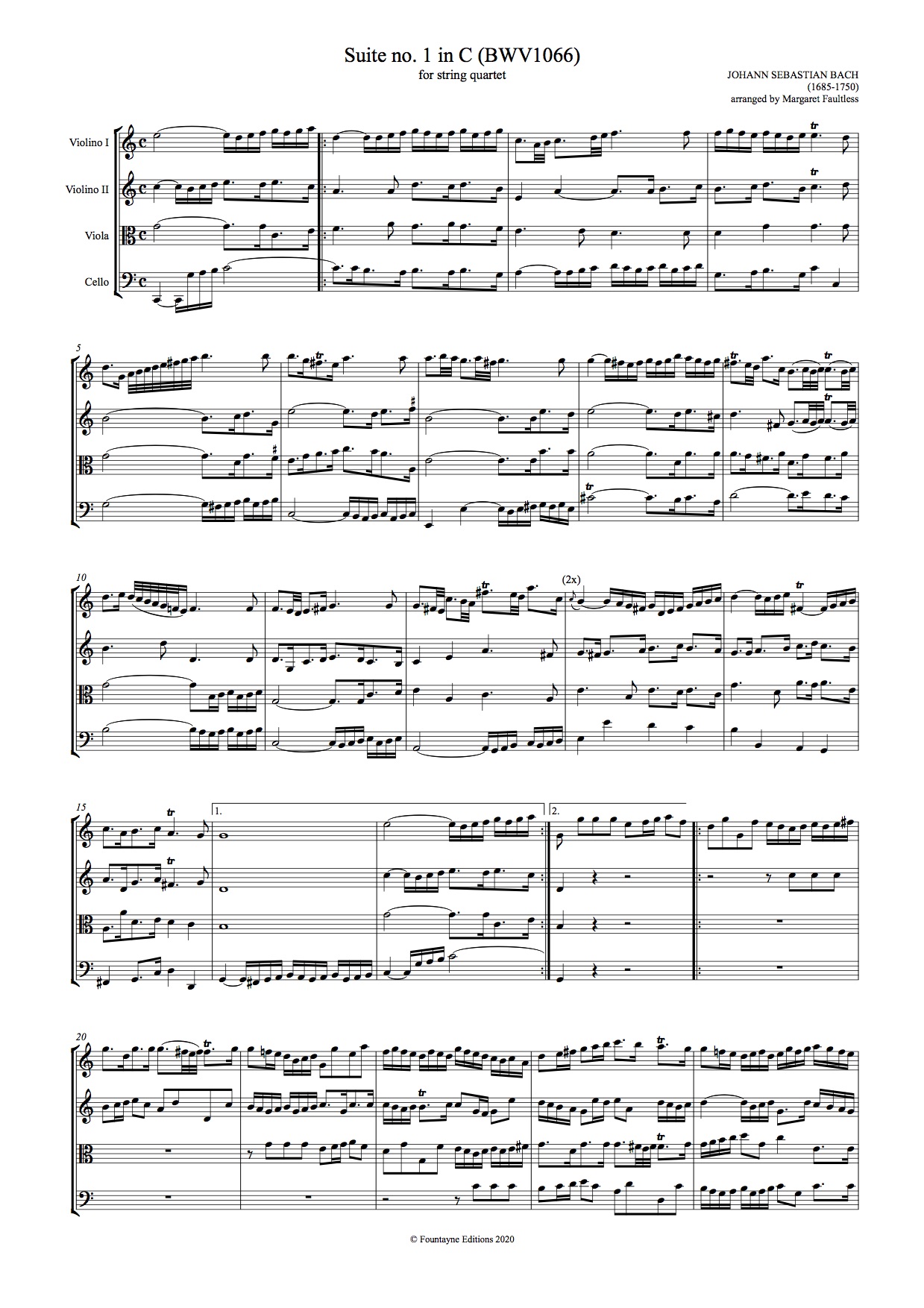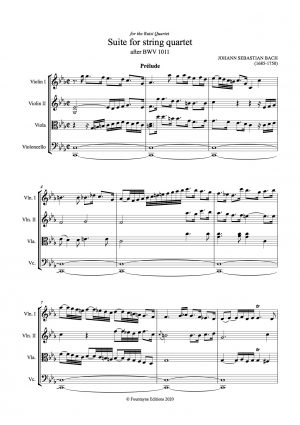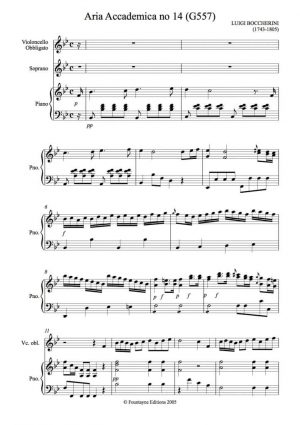Bach, Johann Sebastian Four Suites BWV1066-69 arranged for string quartet
£25.00
Description
Bach, Johann Sebastian Four Suites BWV1066-69
arranged for string quartet by Margaret Faultless
Johann Sebastian Bach’s ‘Overtures’, or Orchestral Suites as they are now known, have their origins in dance suites that were popular in the 1600s. The word ‘orchestral’ suggests a large ensemble of players but in Bach’s time they would have been performed by only a few (or even single) string players on each part. They were not conceived as a set, and were likely partially written while Bach was working in the court at Cöthen (1717–23) and then later when he assumed the role of director of the Collegium Musicum in Leipzig in 1729. The suites follow the pattern of a French Overture followed by dance movements, each with their own distinctive character.
I first fell in love with Bach’s orchestral suites as a teenager. I have now been performing and recording them for over four decades under the direction of pioneering musicians such as Gustav Leonhardt, Frans Brüggen, Sigiswald Kuijken, Ton Koopman and William Christie, in ensembles including the Orchestra of the Age of Enlightenment and the Amsterdam Baroque Orchestra. I have also directed many performances from the violin, including a recent series of concerts featuring all four suites with the OAE. My personal relationship with this music continues to be influenced by the insights and revelations of other directors and colleagues into the nuanced language of Baroque harmony, articulation and phrasing, subtle rhythmic inflection and the character of each dance.
The inspiration behind these arrangements for string quartet has come from my rich and varied experiences as a performer. The confidence and opportunity to complete and edit them has arisen due to some unexpected time for research this year.
Arrangements of multi-part, ‘orchestral’ music for smaller forces are not new. Bach himself borrowed and adapted his own music for different occasions, and the concept of ensemble music with rigidly-scored instrumentation was not one with which early-18th-century musicians would have been familiar. Arrangements have enabled audiences and players to experience music they would not have been able to recreate or reproduce. Some well-known historical examples include Johann Peter Salomon’s arrangements of Haydn’s ‘London’ symphonies, as well as numerous contemporary arrangements of Beethoven’s symphonies for a variety of chamber groups. With those examples in mind, these quartet versions of the Bach suites emerged.
For many years the chamber ensemble Music for Awhile has performed Bach in country churches, through sponsorship from the Cecil King Memorial Foundation. Sometimes the available performing space is extremely small. On one occasion, I suggested programming an intimate arrangement of the third orchestral suite (BWV 1068) with just four strings, one oboe and harpsichord. Colleagues were happy to perform it, for which I will always be grateful. As I discovered, this arrangement did not require cutting harmonic or melodic material, nor losing the detail of inner parts. While the wind, brass and timpani add glorious colour and texture to the music, they do not supply additional melody or harmony, and the pared-down instrumentation was perfect for the occasion. Our performance in a tiny church was a success. Audience members familiar with the original remarked that they heard other instruments in their heads, and that this slim-line performance was thrilling, partly because they were seated so close to the performers. A more audacious version later that season for string quartet alone was also well-received. This led me to a more detailed examination of the Overtures (Bach’s own description of the suites) from the perspective of instrumentation, and I became more daring.
The next arrangement was of the first suite (BWV1066) originally scored for strings, continuo, two oboes and bassoon. In this suite the wind players take on solo roles in the overture and in some of the dance movements. During these moments for wind trio, the strings are either silent, or have a unison line as an accompaniment or commentary. The solution was for the oboe and bassoon solos to be given to violins and cello, while the viola player supplied the accompanying line. Yet again, there were virtually no bars in which independent material was missing, and where there were omissions, it was possible to exchange notes between parts to complete the texture. After many years of hearing outstanding colleagues play these solos, although I can’t claim to add anything to their interpretation, it’s uplifting to pretend to be an oboe and enjoyable to listen to cellists playing the bassoon part.
Bach scholarship has revealed that there was an early version of the B minor flute suite (BWV1067) for strings only, with a violin solo in place of the flute. As with Bach’s alternative versions of other concerti (in which he exchanged harpsichords for strings, for example), it is possible that the string version was transposed to another key, A minor. I have experimented with this, but the colour of B minor fits the piece exquisitely. It’s an excellent key for the flute, and whether I’ve been influenced by years of the music lying under my fingers in B minor, or a subtler relationship with Baroque temperaments, I’ve chosen to keep each of the four suites in their original key. Almost all of the material is preserved by giving the first violin the solo flute passages, with small alterations to the second violin and viola parts.
The fourth suite was significantly more challenging to confine to a quartet as one of its chief characteristics is the dialogue between instrumental groups. Nevertheless, some movements lent themselves fairly easily to a four-part arrangement. In other places, by turning musical conversations into monologues a four-part texture emerged. It is further away from the original, but, in the absence of wind and brass players, or for a small venue, or simply for the sheer joy of playing Bach alongside other quartet repertoire, here is a version in four parts.
Acknowledgements
Alongside all the colleagues with whom I’ve performed the suites over many years I am indebted to Nia Lewis, Anna Curzon and Andrew Skidmore for playing these new arrangements with me and suggesting improvements, to Andrew for enjoyable Zoom meetings discussing how to write about performance practice, to Rachel Stroud for editing the forward, to the historical dance expert Mary Collins for her article on Baroque dance and for her research and advice over many years, to publisher and General Editor of Fountayne Editions, Roy Mowatt for his enthusiasm and patience with many requests to make changes, and to the Cecil King Memorial Foundation, without whose continued support for Music for Awhile this project could not have happened.
Maggie Faultless, Alton Barnes, August 2020
Head of Historical Performance, Royal Academy of Music, London
Director of Performance, Faculty of Music, University of Cambridge
Co-Leader, Orchestra of the Age of Enlightenment
score £25
parts £25
Additional information
| choose | parts, score |
|---|






